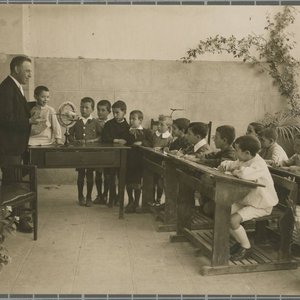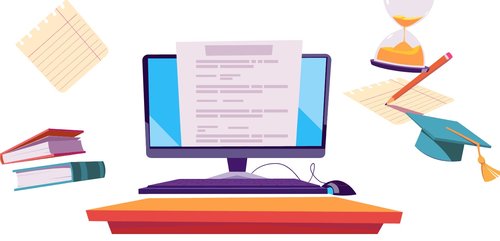
This article includes examples to inspire institutions which are thinking about re-using their archaeological digital content for learning.
(Image credit: Aula d'escola, Girona City Council, Public Domain)
Europeana, recognising that cultural heritage has an important role to play in education, has been building up resources and activities to “bring this source of knowledge to every learner, educator or educational organisation” (Europeana Education). However, are cultural heritage and education institutions ready to follow and more importantly where should they turn to for guidance and advice?
Back in 2016, CARARE collaborated with the Discovery Programme and the Fab Lab to organise “Upcycle Digital Heritage” in Derry: two days of events which included hands-on workshops for teachers and schoolchildren to create, use and reuse 3D cultural heritage content, and brought together people from the culture, education, tourism and creative industries sectors to discuss ways of using and re-using cultural heritage digital content.
Since then the Discovery Programme has organised events and workshops for secondary education on recording cultural heritage and processes in archaeology. It has produced content specially for use in schools ranging from the Discovering the Bronze Age worksheets and teachers’ notes as well as teaching suggestions packs, to 3D Models. Its 3D Icons website and its Sketchfab page contains 3D models of many of the archaeological site types included in history and Art Curricula. For example, the model of the Cross of the Scriptures contains many hot points which provide information on the scenes depicted on the high cross.

These models are a valuable tool to help students learn about the history and symbolism and art of these crosses, while they can remodel objects virtually. Further content includes Guidebooks for school students with cartoons, photos, maps and plans of the sites, and the Guide to the Hill of Tara intended for school tours to this National Monuments or just to learn more about one of Ireland’s royal sites.
Anthony Corns, the Technology Manager at The Discovery Programme stressed the difficulties of this effort: “It is hard to engage as the curriculum is so strict and makes it difficult for teachers”. He also commented that digital archaeology content needs to fit in specific classes on history, geography or art. “Unless a support mechanism is provided to enable to work with secondary education the curriculum is so strict, and so is the timeframe. It is difficult to link digital archaeology. COVID added further barriers”
The Vágar model produced by the CINE project is an example of how digital cultural heritage content can be re-used in apps and serious games. For example in games where historical photographs can be placed digitally in the physical landscape. The CINE Wayfinder is a cost free toolbox which allows school teachers, small heritage organisations and other users to browse through best practice examples, explore what digital tools the project has made and find references on how these have been used.
Visual Dimension is another CARARE member who has been working over a number of years creating digital content for re-use in education. Its long running work to digitise Saint Salvator abbey and its vicinity in Ename using 3D technologies has been re-used to create 3D reconstructions, a Virtual Reality Application, Serious Games and 3D printed models for exhibitions and educational visits. Guides at the Ename Museum have access to games for use with school groups including: The 1290 game, Eham 1291 game and Ename in 1665
Marinos Ioannides and his team at the Digital Heritage Research Lab of the Cyprus University of Technology have re-used the 3D digital model of the Byzantine church at Asinou in Cyprus for education, in creative workshops in elementary schools in Limassol, at the Mediterranean Science Festival and in an interactive book and an Augmented Reality App for elementary schools in Cyprus.
AD&4D have worked with cultural heritage sites and communities to use 3D technologies to produce digital content for re-use. For example, the 3D models of the Torre de Alfarp, the Torre dels Coloms (Alzira) and the Torre de Antella, have been printed in 3D with braille panels to provide access for people with visual impairments. These techniques would have an important place in schools where experiential models can replace memorising. Pedro Cifuentes teacher and draftsman, describes his experience having used AD&D 4D’s work: "The infographics, 3D reconstruction and photogrammetry of archaeological sites has been a real boost in the way I have been teaching the subject "Geography and History…the possibility of visiting the sites without leaving the classroom, projecting tours on a large screen or allowing students to work with the virtual tour from their own electronic devices, is a very important boost for my work. A boost that has been highly valued by the students as it has allowed us to carry out "gamification" and "storytelling" dynamics…”
Sharing your content
If your institution would like to share its digital content for learning it may benefit you to take a look at Europeana Classroom. This provides resources for educators, learners and parents, with highlights, examples of learning scenarios and educational resources based on digital content available on Europeana.
Historiana is an online platform for students and teachers developed by EuroClio (the European Association of History Educators) with partners including Europeana, which supports the use of cultural heritage collections in education. Institutions which become partners can showcase their digital collections (in Historiana.
Europeana is building partnerships with ministries of education, European Associations and Networks, and the Industry. Some of these may help your institution to open up in formal and non-formal education.
If you would like to find out more about how to share your collections with Europeana for learning, you can visit https://pro.europeana.eu/page/education or get in touch with CARARE to guide you through Europeana’s options.